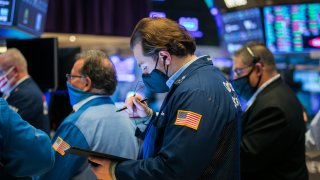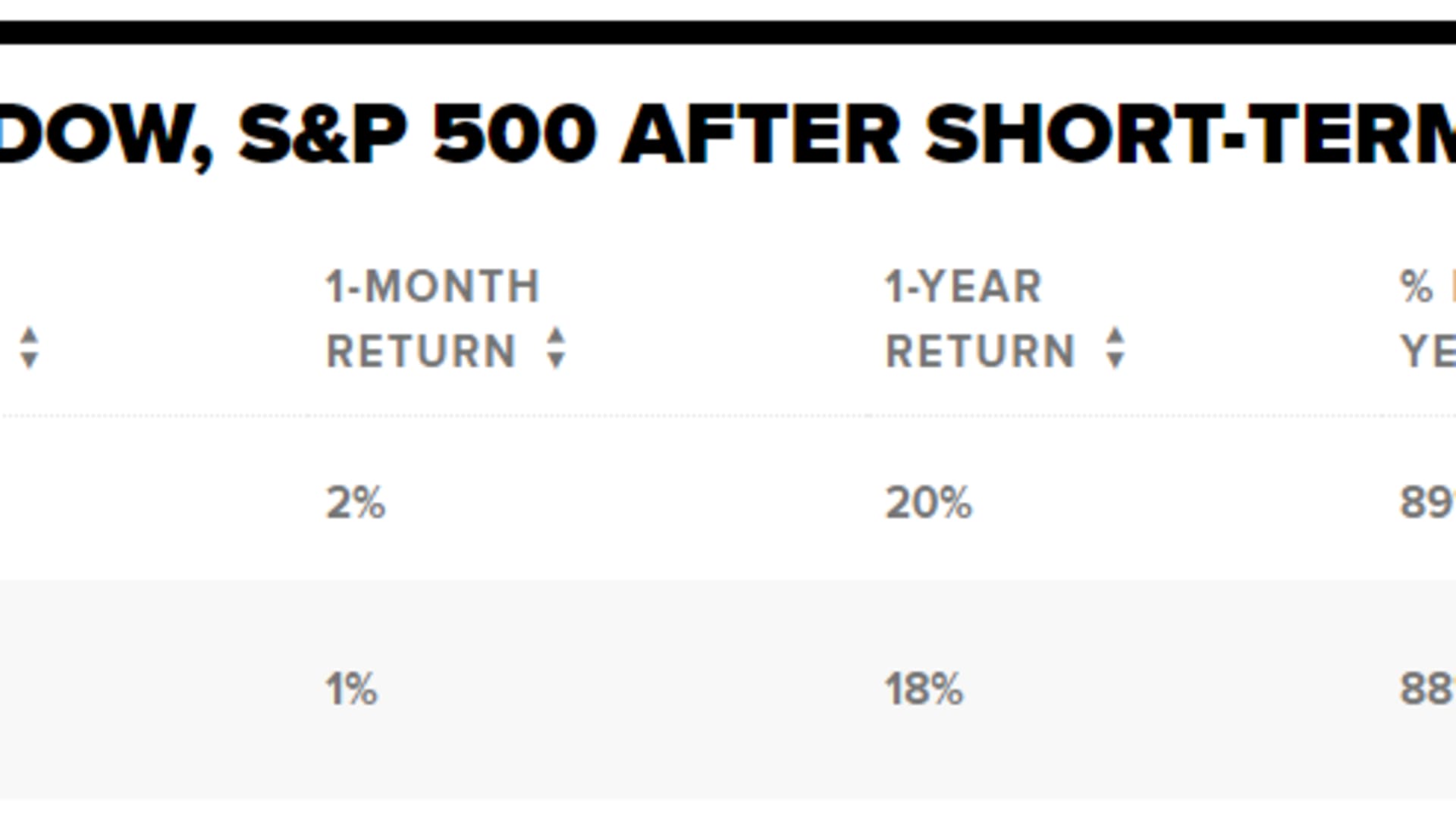
- The Dow Jones Industrial Average and S&P 500 Index surged between Election Day and Monday, when Pfizer announced its Covid-19 vaccine trial data.
- The last two days saw a pullback in stocks as coronavirus cases hit new records and public health experts say the worst of the pandemic will be in the months ahead.
- Market history says that after huge short-term gains like the U.S. market just experienced, expect volatility, but the record also shows that longer-term, investors can benefit.
Market volatility to the downside may not be entirely behind us, as the last two days of trading in U.S. stocks and the Dow Jones Industrial Average just reminded investors, with a dip of more than 300 points on Thursday. But since the week of Election Day, and through the encouraging Pfizer coronavirus vaccine data released on Monday, stocks had surged. The Dow spiked by 10% over six days, and the S&P 500 Index just under 9% during the same bullish run that culminated in the coronavirus vaccine trial results.
So is the selling just getting started, or will the stock momentum pick up again?
Market history says the answer is both No and Yes. For traders, more short-term volatility should be expected. But for investors with a little patience, the bullish signals for the next year look more solid. Here's the data that explains it.
The Dow has posted a return of 10% or more in a span of six days only 10 times in market history dating back to the 1960s, according to a research analysis from Truist/SunTrust Advisory chief market strategist Keith Lerner, using FactSet data. That's not a data set sizable enough to draw supreme confidence from, but the record is a strong one for the one-year period that follows.
Historically, following such strong price action, short-term market returns have been mixed, looking over multiple trading windows — two weeks, one month, and even out to three-months That's potentially bad news for traders, which can make the last two days a source of concern. However, a year later, the Dow averaged a gain of 20% and was up in every historical trading window, except one -- following March 2000.
The same pattern holds true for the S&P 500, which was up 8.6% over six days through Monday's Pfizer vaccine announcement, and it provides more historical data to work with than the Dow. That level of short-term momentum in the S&P 500 has occurred 26 times since 1962. Similar to the Dow, the short-term market returns for the S&P were mixed after those historical runs, but a year later, the S&P 500 was up 88% of the time with an average return of 18%. The three periods of negative one-year returns all occurred in the context of the 2000-2002 bear market.

There's still plenty to worry about. Coronavirus cases are reaching new records again across the U.S. and Europe, new restrictions are being imposed, and some level of lockdowns is looking more likely. Former FDA commissioner Dr. Scott Gottlieb, who is on the board of Pfizer, called the recent hospitalization numbers "really staggering" at a CNBC virtual event on Thursday. Hospitalizations reached a record of 67,096. Illinois Governor J.M. Pritzker said his state is running out of options and he warned of another stay-at-home order if the situation doesn't improve.
Money Report
A U.S. election is still being disputed and control of the U.S. Senate still up in the air, and talks on Capitol Hill for more financial relief still showing a wide gap between Democratic Party and Republican Party positions.
Meanwhile, recent economic data has been strong. Nonfarm payroll growth for October was better than Wall Street expected and weekly jobless claims fell last week to their lowest level since March. But economists are worried a slowdown could be triggered by the coronavirus.
The view from the Federal Reserve
The Federal Reserve remains concerned. Fed chair Jerome Powell said on Thursday, "We're recovering, but to a different economy and it will be one that is more leveraged to technology, and I worry that it's going to make it even more difficult than it was for many workers."
Powell said even with unemployment going down and a vaccine potentially closer, the next few months will be challenging — a view shared by leading public health experts like Dr. Anthony Fauci and Dr. Gottlieb, who told CNBC on Thursday that the "hardest months" of the pandemic were coming. As a result, more support will be needed for Americans. "It's too soon to assess with any confidence the implications of the news for the path of the economy, especially in the near term," Powell said at the European Central Bank forum on Thursday.
Stock rose on Friday morning after the Thursday selling in the Dow and were on track for a winning week even amid the recent bumpiness.
SunTrust's Lerner views Fed support as one of the reasons the investment outlook is better now than it was after the 2000 bullish surge which preceded the dotcom bubble burst, the only historical window in which these short-term runs in stocks did not foretell greater gains a year later.
He doesn't see the 2000 data point as a precedent for the current market because the economy was at a very different stage than the current one — late in an extended bull market and economic expansion with the Federal Reserve tightening right before the technology bubble burst.
The economic backdrop is "quite different" today, in the view of the Suntrust strategist. Monetary policy is "very easy," and after what was the sharpest and shortest recession in U.S. economic history, it is fair to argue we are in the early innings of an economic expansion.
Covid surges and market corrections
Short-term volatility in stocks is reasonable to expect. After a run like the market just had, "much of the fuel from the release of tension due to positive coronavirus vaccine news and moving past election night appears to have been exhausted," Lerner says.
Covid cases keep going up, but there are vaccines on the horizon and belief there may be more limited lockdowns than experienced last spring. Dr. Fauci said on Good Morning America on Thursday, "I believe that we can do it without a lockdown, I really do." Though a medical advisor to Biden has floated the idea of a four- to six-week national lockdown to ultimately help the economy. Limited lockdowns and more good news on the vaccine front could blunt downside in stocks.
"There is a light at the end of the tunnel. It doesn't mean we won't have a correction. We had one in September," Lerner said. That is why portfolios should always include assets like high quality fixed-income as a hedge. "The range of outcomes is wider than it would have been before," he added, because of Covid.
But the market strategist remains positive on a 12-month basis, based on the belief that the market is seeing the early stages of a multi-year economic expansion, as well as the fact that stocks are typically valued on cash flow generation over multiple years, which should help investors look through the current rise in Covid-19 cases and potential slowing in parts of the global economy.
The historical data set on Dow and S&P short-term surges, while limited, also supports this view that investors who hold onto equities may stand to benefit.
"It could be volatile. We can get overextended or overbought in between," Lerner said. "But strong momentum more times than not is a real positive looking out six to 12 months, even if the short-term is mixed."






